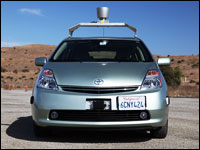
The hype around driverless cars, or autonomous vehicles as they’re also known, is increasing, with Google on Tuesday taking reporters for spins around the city of Mountain View, Calif.
Figuring prominently in resulting news reports were the big red kill button between these cars’ front seats; the emphasis on safety in their design; and yes, a few abrupt lane changes and one case of shuddering at a turn when a bus was close by.
Still, there’s no denying that the auto industry is gaga about autonomous vehicles.
Mercedes-Benz, Audi, BMW, Ford, GM and Hyundai are among the companies working on this technology, while Volvo will put 100 autonomous vehicles on the streets of the Swedish town of Gothenburg beginning in 2017. Nissan plans to begin selling driverless cars by 2020.
Google led the formation of the Open Automotive Alliance, a coalition including major auto manufacturers, to stimulate the use of Android in cars.
Battling for the Big Bucks
The potential of the autonomous vehicle market is huge: Vehicles with provisions for driver control will hit the market in 2025, while autonomous-only vehicles will arrive in 2030, according to IHS Automotive.
Total worldwide sales of self-driving vehicles will grow from about 230,000 in 2025 to 11.8 million in 2035, the firm predicted. Nearly 5 million of the vehicles sold in 2035 will be autonomous-only.
By 2035, nearly 54 million autonomous vehicles will be in use worldwide, IHS predicted. After 2050 nearly all of the vehicles in use, both personal and commercial, will be autonomous.
Obstacles to Autonomous Vehicle Sales
“The laws don’t exist to govern fully automated cars today,” Praveen Chandrasekar, telematics and infotainment research manager at Frost & Sullivan, told TechNewsWorld. Further, the legal definition of an autonomous vehicle that will be accepted by departments of motor vehicles has not yet been worked out.
Then there is the question of liability, Chandrasekar pointed out. “What if a driverless car gets into an accident? Who will be blamed? You’ll get a tangle of lawsuits.”
However, products liability law has been “remarkably adaptive” to new technologies, and, on the whole, the courts “have generally proven quite capable” of addressing this issue when it comes to new technologies and products, noted Brookings Institute researcher John Villasenor.
“Given this strong record of adaptation to new technologies, there is no reason to expect that the legal system will be unable to address the products liability issues that arise with respect to autonomous vehicles,” he wrote.
Interestingly enough, technology will be a trouble spot when it comes to marketing automotive vehicles.
“The sheer amount of failsafe redundancies you’ll have to create, the AI you’ll have to build into the car to determine, for example, when the driver is ready to take control of the car, are issues,” Chandrasekar noted. “What if the driver’s taking a nap when the vehicle wants to revert control to him?”
It’s likely these problems will largely be solved by 2025-2030, Chandrasekar said.
Cheaper by the Million
Currently, Google’s autonomous vehicles have about $150,000 worth of equipment, making them a very expensive proposition.
By 2025, self-driving car technology will cost about $7,000 to $10,000, IHS predicted.
This will fall to about $3,000 by 2035, when only fully autonomous vehicles will be offered.
Better Safe Than Sorry
However, one issue — safety — may continue to plague auto manufacturers.
There is no such thing as perfect software — all code has flaws, some of which appear earlier than others — and the public outcry that might result if one person were injured or killed because of a software glitch in a driverless car could be devastating.
Some people compare autonomous vehicles to jetliners, which essentially are flown by autonomous systems, “but they forget the pilot is still there, a highly trained professional, who takes over if something goes wrong,” remarked Mark Fitzgerald, associate director of automotive practice at Strategy Analytics.
Also, “jets have incredible maintenance procedures,” he pointed out, “whereas car owners may do their oil changes and not take the vehicle to the dealer.”























































Two things kill self driving cars. The first is habitual traits of humans who have always driven and been in control of their vehicle. Remember even when we are not driving we sometimes are the proverbial back seat driver. Second, is the fear factor that something will drastically go wrong in the gradual change over to self driving vehicles. Namely, a loss of control, how will they react to bad human driving actions and also how comfortable will a human be allowing a computer to drive. We have witness this in airlines in a reluctance to have pilot free airplanes. By nature, humans want to be in control and if they cannot they want to entrust another human to do that. I have my doubts that this will change for the sake of technology.